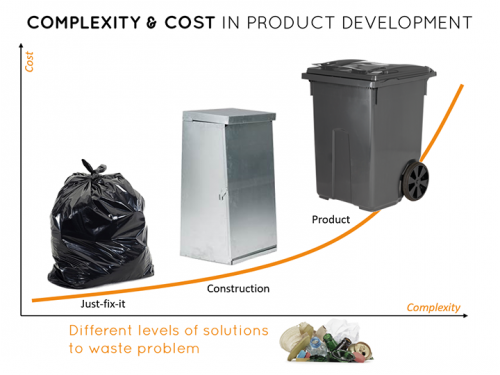Tips: Skapa samsyn kring produktutvecklingens komplexitet
Tip: Create a common view on product development complexity

(Scroll down for English)
Ni som arbetar med produktutveckling har säkert upplevt att andra inom företaget inte förstår varför utvecklingsprojekten tar tid och kostar…
”Varför ska det behöva ta så lång tid? Det är väl bara att…”
…och ni som arbetar med styrning och beslut i produktutvecklingsprojekt är säkert lika frustrerade när projektledaren kommer och vill justera tidplanen…
”Konstruktörerna behöver mer tid att förfina plastkomponenterna innan…”
Känner ni igen det? Tänkte väl det! Här får ni ett tips på hur ni kan skapa gemensam förståelse för produktutvecklingens komplexitet.
Ett produktutvecklingsprojekt involverar en mängd funktioner och kompetenser i företaget. En del har mycket erfarenhet och arbetar bara med utveckling, andra har endast en mindre del av sin arbetstid för projektet och vissa är endast involverade i styrning och kontroll av arbetet. Detta innebär att erfarenhet och kunskap om det faktiska produktutvecklingsarbetet varierar kraftigt.
Det är en stor risk att för missförstånd, underskattning, frustration och konflikter. För att involvera och skapa förståelse för komplexiteten i produktutveckling brukar jag använda det här exemplet med att utveckla lösningar för sophantering:

Problem
Vi har en hög med skräp vi behöver ta hand om.
Olika nivåer av lösningar
1: Just-fix-it – Det absolut enklaste sättet att lösa problemet är att ta en sopsäck och lägga skräpet i. Snabb, enkelt och billigt. Här finns få krav på lösningen. Skräpet behöver inte sorteras, säcken behöver inte återanvändas, inga krav på ergonomi eller att det ska fungera i kommunens sophanteringssystem.
2: Konstruktion – På denna nivå har problemet lösts med en sopbehållare i plåt som har en sopsäck i papper. Kraven på lösningen är högre här. Den ska bära och skydda sopsäcken, interagera med personer som slänger skräp och andra som kommer för att hämta säcken. Den ska ha lock och dörr, kunna stå stadigt och tåla väder och vind. Det är få krav på ergonomi och mobilitet. Produkten är gjord i bockad plåt med borrade hål för skruvmontage och kräver inga dyra tillverkningsverktyg.
3: Produkt – På den högsta nivån har vi ett sopkärl för källsortering. Här är kraven mycket höga. Produkten ska vara en del i ett stort sophanteringssystem och fungera för en mängd intressenter: villaägaren, sophämtaren, sopbilen och renhållningsbolaget. Kärlet ska ha olika fack för de olika materialfraktionerna som ska kunna tas ut och tömmas var för sig. Höga krav på ergonomi för att minimera risken för arbetsskador, vilket innebär integrerade handtag, hjul och låg vikt. Automatisk tömning kräver att sopbilen kan få tag i kärlet och lyfta/tömma utan att det bryts sönder. Det är också krav på lång livslängd, att det ska tåla hantering samt väder och vind. Dessutom ska kärlet tillverkas i stora antal, till låg kostnad och med hög kvalité vilket kräver stora investeringar i formsprutningsverktyg. Just verktygsbundna detaljer innebär hög grad av förfining och att allt är väl genomtänkt och testat innan man kan börja tillverka. Detta tar tid och kostar pengar.
Som ni förstår är det alla de olika kraven som gör att det är mycket mer komplext att utveckla ett sopkärl än att bara ta en sopsäck. Detta diagram visar hur kostnaden relaterar till komplexiteten.

Med hjälp av exemplet kan ni skapa förståelse för produktutvecklingens komplexitet och skapa förutsättningar för en konstruktiv dialog inom företaget. Genom att översätta exemplets nivåer till de egna produkterna, kan ni skapa en samsyn kring förväntningar och krav på den nya produkten.
Hoppas ni får nytta av denna artikel. Hör gärna av er och berätta hur det gick!
ENGLISH
Those who work with product development have surely experienced that others within the company do not understand why development projects take time and costs…
“Why should it take so long? Just do it… “
… and you who work with management and decision in product development projects are certainly as frustrated when the project manager comes and wants to adjust the time plan …
“The engineers need more time to refine the plastic components before …”
Do you recognize that? Thought so! Here you will find tips on how to create a common understanding of product development’s complexity.
A product development project involves many functions and competencies in the company. Some have a lot of experience and work only with development, others only have a small part of their working time for the project and some are only involved in steering and controlling the work. This means that experience and knowledge of the actual product development work varies considerably.
There is a high risk of misunderstanding, underestimation, frustration and conflicts. In order to involve and create understanding of the complexity in product development, I use this example about developing solutions for waste management:
Problem
We have a pile of waste we need to take care of.
Different levels of solutions
1: Just-fix-it – The easiest way to solve the problem is to take a waste bag and put the waste in it. Fast, easy and cheap. There are few demands on the solution. The garbage does not need to be sorted, the bag does not need to be reused, no demands on ergonomics or that it shall work in the municipal waste management system.
2: Construction – At this level, the problem has been solved with a waste bin in sheet metal, that has a sack in paper. The requirements for the solution are higher here. It shall carry and protect the bag, interact with users and others who come to pick up the sack. It should have a lid and door, be able to stand firm and withstand weather and wind. There is little need for ergonomics and mobility. The product is made of bended plates with drilled holes for screw mounting and does not require expensive manufacturing tools.
3: Product – At the highest level we have a waste bin for sorting. Here the requirements are very high. The product should be part of a large waste management system and work for a variety of stakeholders: the house owner, the collector, the garbage truck and the waste management company. The bin shall have different compartments for the different material fractions that can be removed and emptied separately. High ergonomics requirements to minimize the risk of occupational injuries, which means integrated handles, wheels and low weight. Automatic emptying requires that the trash can get hold of the bin and lift/empty without breaking it apart. It is also a requirement for long life, that it will withstand handling as well as weather and wind. In addition, the vessel is to be manufactured in large numbers, at low cost and high quality, which requires large investments in injection moulding tools. Tool-based components mean a lot of refinement and everything is well thought out and tested before you can start manufacturing. This takes time and costs money.
As you can see, it’s all the different requirements that make it much more complex to develop a waste bin for sorting than just taking a plastic bag. This chart shows how the cost relates to the complexity.
Using this example, you can get an understanding of product development’s complexity and create the conditions for constructive dialogue within the company. By translating the sample’s levels into your own products, you can create a consensus about expectations and requirements for the new product.
Hope you will benefit from this article. Please tell me how it went!
